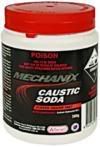
The fats used in soap are chosen based on their individual characteristics. ie sweet almond for moisturising and lather, calendula oil for healing and soothing, coconut oil for lather and hardening the soap etc.
A list of oils and their properties is here.
The lye is highly alkaline and can cause severe burns if you get it on your skin. You need to wear gloves and work in a well ventilated area to avoid the fumes. The good thing is that there is no lye in the end product. The lye and the fat counteract each other when in the correct proportions, leaving nothing but pure glycerin soap. Most store bought soap has had the glycerin removed, to be sold as a seperate product. Handmade soap still contains all the natural moisturising glycerin.
When you mix the fat/lye mixture together, it will come to a stage called 'trace'. This is when the lye has done most of its work with the fat and the mixture thickens up to about the consistency of cake batter. At this point it is possible to add some extra oils that will not be canceled out by the lye (called superfatting), fragrances, exfoliants etc. You can use essential oils, salt, sugar, clay, flowers, herbs, food dye, moisturising oils like jojoba, sweet almond or grapeseed, honey, coffee, oatmeal etc etc.
The moulds you use dont need to be anything spectacular - empty containers, biscuit or muffin trays, chocolate moulds etc. The soap will have to stay in the moulds for a day or so to harden up a little bit. If you have trouble getting the soap out of the moulds, chuck it in the freezer for an hour or two to shrink the soap. It should all just fall out when you invert it. If you used a large tray or container you can cut the soap into bars with a sharp knife or you can use some fine wire or fishing line.
Then comes the hard part. You have to leave it for weeks and weeks to cure. After the first two weeks the saponification process is completed. After that, it's just a case of letting it dry out. The longer you can leave it, the harder it will get, the longer it will last, the milder it will get and you will get a richer lather. Around 6-9 weeks is normal. You could use it after the 2 weeks but you will have a really soft bar and could end up with a sloppy mess in the shower.




0 comments:
Post a Comment